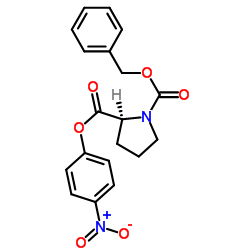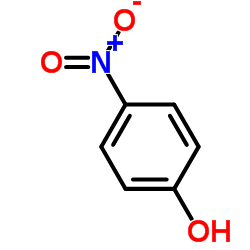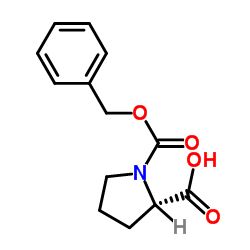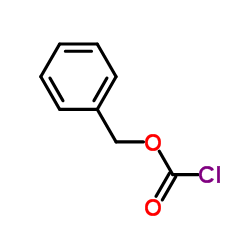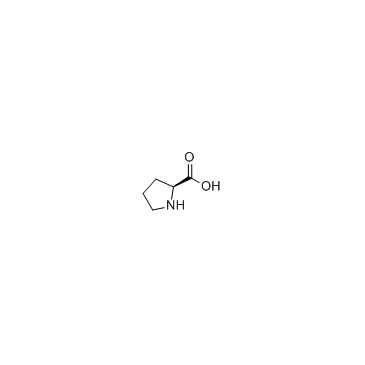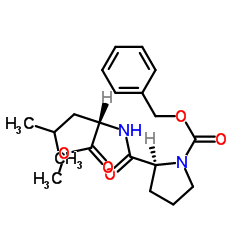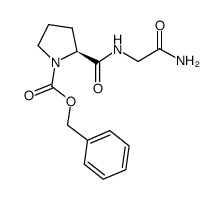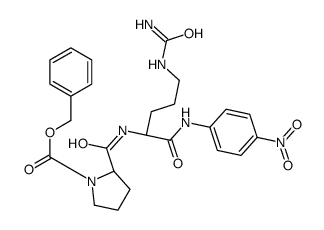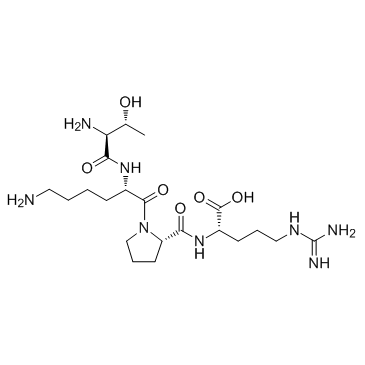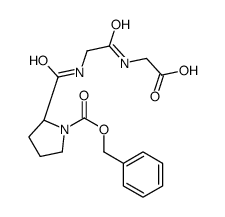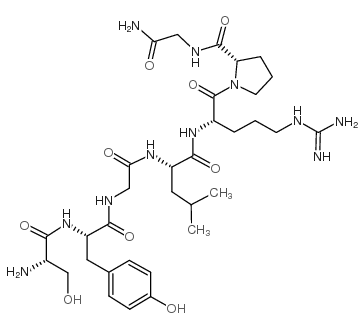3304-59-4
| Name | z-pro-onp |
|---|---|
| Synonyms |
Carbobenzyloxy-L-proline p-nitrophenyl ester
CARBOBENZYLOXY-L-PROLINE 4-NITROPHENYL ESTER (S)-1-Benzyl 2-(4-nitrophenyl) pyrrolidine-1,2-dicarboxylate N-benzyloxycarbonyl-L-proline p-nitrophenyl ester MFCD00020828 1,2-Pyrrolidinedicarboxylic acid, 2-(4-nitrophenyl) 1-(phenylmethyl) ester, (2S)- carbobenzyloxy-l-prolinep-nitrophenylester Z-L-PROLINE NITROPHENYL ESTER EINECS 221-981-3 P-NITROPHENYLCARBOBENZOXY-L-PROLINE Z-PROLINE-ONP N-CARBOBENZOXY-L-PROLINE-P-NITROPHENYL ESTER N-CBZ-L-PROLINE P-NITROPHENYL ESTER L-Proline, carbobenzyloxy-, p-nitrophenyl ester N-carbobenzoxy-DL-proline p-nitrophenyl ester 1-Benzyl 2-(4-nitrophenyl) (2S)-pyrrolidine-1,2-dicarboxylate benzyloxycarbonyl-L-proline p-nitrophenyl ester 1-Benzyl 2-(4-nitrophenyl) (2S)-1,2-pyrrolidinedicarboxylate carbobenzyloxy-l-prolinp-nitrophenylester Z-L-PROLINE 4-NITROPHENYL ESTER Z-L-Pro-ONp |
| Density | 1.4±0.1 g/cm3 |
|---|---|
| Boiling Point | 541.7±50.0 °C at 760 mmHg |
| Molecular Formula | C19H18N2O6 |
| Molecular Weight | 370.356 |
| Flash Point | 281.4±30.1 °C |
| Exact Mass | 370.116486 |
| PSA | 101.66000 |
| LogP | 2.95 |
| Vapour Pressure | 0.0±1.4 mmHg at 25°C |
| Index of Refraction | 1.611 |
| Storage condition | 2-8°C |
|
Version 1.2
Regulation (EC) No 1907/2006 1 - Product and Company Information Product NameN-CBZ-L-PROLINE P-NITROPHENYL ESTER CRYSTALLINE 2 - Hazards Identification 3 - Composition/Information on Ingredients Product NameCAS #EC noAnnex I Index Number N-CBZ-L-PROLINE P-NITROPHENYL3304-59-4 221-981-3 None ESTERCRYSTALLINE FormulaC19H18N2O6 Molecular Weight 370,4000 AMU Synonyms1-Benzyl p-nitrophenyl L-1,2-pyrrolidinedicarboxylate * Carbobenzyloxy-L-proline p-nitrophenyl ester * L-Proline, carbobenzyloxy-, p-nitrophenyl ester 4 - First Aid Measures AFTER INHALATION If inhaled, remove to fresh air. If breathing becomes difficult, call a physician. AFTER SKIN CONTACT In case of skin contact, flush with copious amounts of water for at least 15 minutes. Remove contaminated clothing and shoes. Call a physician. AFTER EYE CONTACT In case of contact with eyes, flush with copious amounts of water for at least 15 minutes. Assure adequate flushing by separating the eyelids with fingers. Call a physician. AFTER INGESTION If swallowed, wash out mouth with water provided person is SIGMAwww.molbase.com conscious. Call a physician. 5 - Fire Fighting Measures EXTINGUISHING MEDIA Suitable: Water spray. Carbon dioxide, dry chemical powder, or appropriate foam. SPECIAL RISKS Specific Hazard(s): Emits toxic fumes under fire conditions. SPECIAL PROTECTIVE EQUIPMENT FOR FIREFIGHTERS Wear self-contained breathing apparatus and protective clothing to prevent contact with skin and eyes. 6 - Accidental Release Measures PROCEDURE(S) OF PERSONAL PRECAUTION(S) Wear protective equipment. METHODS FOR CLEANING UP Sweep up, place in a bag and hold for waste disposal. Avoid raising dust. Ventilate area and wash spill site after material pickup is complete. 7 - Handling and Storage STORAGE Store at 2-8°C 8 - Exposure Controls / Personal Protection ENGINEERING CONTROLS Mechanical exhaust required. PERSONAL PROTECTIVE EQUIPMENT Special Protective Measures: Wear appropriate government approved respirator, chemical-resistant gloves, safety goggles, other protective clothing. 9 - Physical and Chemical Properties AppearancePhysical State: Solid PropertyValueAt Temperature or Pressure pHN/A BP/BP RangeN/A MP/MP RangeN/A Flash PointN/A FlammabilityN/A Autoignition TempN/A Oxidizing PropertiesN/A Explosive PropertiesN/A Explosion LimitsN/A Vapor PressureN/A Partition CoefficientN/A ViscosityN/A Vapor DensityN/A Saturated Vapor Conc.N/A SIGMAwww.molbase.com Evaporation RateN/A Bulk DensityN/A Decomposition Temp.N/A Solvent ContentN/A Water ContentN/A Surface TensionN/A ConductivityN/A Miscellaneous DataN/A SolubilityN/A 10 - Stability and Reactivity STABILITY Stable: Stable. HAZARDOUS DECOMPOSITION PRODUCTS Hazardous Decomposition Products: Carbon monoxide, Carbon dioxide, Nitrogen oxides. HAZARDOUS POLYMERIZATION Hazardous Polymerization: Will not occur 11 - Toxicological Information RTECS NUMBER: UY0750000 ACUTE TOXICITY LD50 Intravenous Mouse 320 MG/KG ROUTE OF EXPOSURE Multiple Routes: May cause irritation. May be harmful by inhalation, ingestion, or skin absorption. CONDITIONS AGGRAVATED BY EXPOSURE The toxicological properties have not been thoroughly investigated. 12 - Ecological Information No data available. 13 - Disposal Considerations SUBSTANCE DISPOSAL Dissolve or mix the material with a combustible solvent and burn in a chemical incinerator equipped with an afterburner and scrubber. Observe all federal, state, and local environmental regulations. 14 - Transport Information RID/ADR Non-hazardous for road transport. IMDG Non-hazardous for sea transport. SIGMAwww.molbase.com IATA Non-hazardous for air transport. 15 - Regulatory Information COUNTRY SPECIFIC INFORMATION Germany WGK: 3 Self-Classification 16 - Other Information WARRANTY The above information is believed to be correct but does not purport to be all inclusive and shall be used only as a guide. The information in this document is based on the present state of our knowledge and is applicable to the product with regard to appropriate safety precautions. It does not represent any guarantee of the properties of the product. Inc., shall not be held liable for any damage resulting from handling or from contact with the above product. See reverse side of invoice or packing slip for additional terms and conditions of sale. Copyright 2010 Co. License granted to make unlimitedpaper copies for internal use only. DISCLAIMER For R&D use only. Not for drug, household or other uses. SIGMAwww.molbase.com SECTION 16 - ADDITIONAL INFORMATION N/A |
CHEMICAL IDENTIFICATION
HEALTH HAZARD DATAACUTE TOXICITY DATA
|
| RIDADR | NONH for all modes of transport |
|---|---|
| WGK Germany | 3 |
| RTECS | UY0750000 |
| Precursor 7 | |
|---|---|
| DownStream 8 | |


